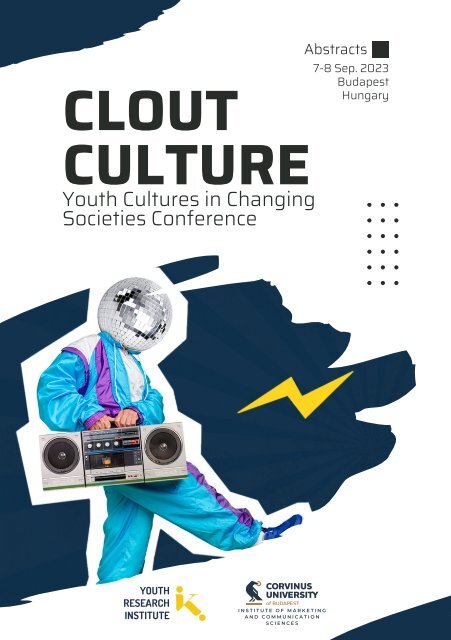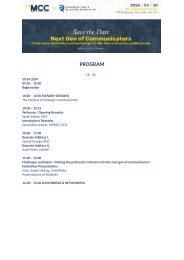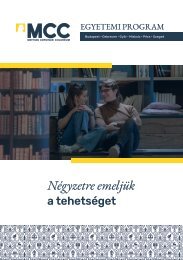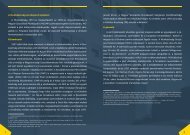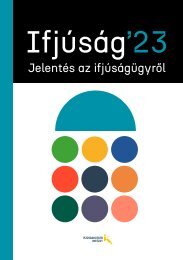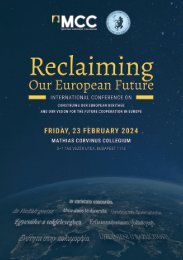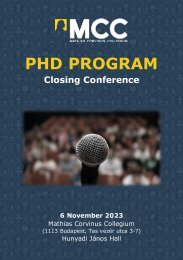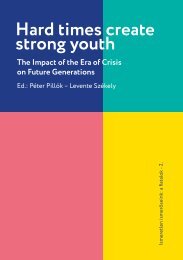Clout Culture - Youth Cultures in Changing Societes Conference
You also want an ePaper? Increase the reach of your titles
YUMPU automatically turns print PDFs into web optimized ePapers that Google loves.
CLOUT<br />
CULTURE<br />
<strong>Youth</strong> <strong>Culture</strong>s <strong>in</strong> Chang<strong>in</strong>g<br />
Societies <strong>Conference</strong><br />
Abstracts<br />
7-8 Sep. 2023<br />
Budapest<br />
Hungary<br />
I N S T I T U T E O F M A R K E T I N G<br />
A N D C O M M U N I C A T I O N<br />
S C I E N C E S
CLOUT CULTURE.<br />
<strong>Youth</strong> <strong>Culture</strong>s <strong>in</strong> Chang<strong>in</strong>g Societies <strong>Conference</strong>:<br />
Abstracts<br />
7-8 Sep. 2023<br />
Budapest, Hungary
BRIEF CONTENTS<br />
Detailed conference programme 4<br />
Abstracts<br />
Panel discussions (7th September) 6<br />
World café discussions (7th September) 9<br />
Lectures (8th September) 21<br />
Panel discussions (8th September) 31<br />
Abstract booklet edited by:<br />
Georg<strong>in</strong>a Kiss-Kozma<br />
<strong>Conference</strong> Organiz<strong>in</strong>g Committee:<br />
Levente Székely, Georg<strong>in</strong>a Kiss-Kozma, Tamás Gyulavári, Réka Benczes<br />
Published by The <strong>Youth</strong> Research Institute and the Institute of Market<strong>in</strong>g and<br />
Communication Sciences at Corv<strong>in</strong>us University of Budapest<br />
www.ifjusagkutato<strong>in</strong>tezet.hu<br />
www.uni-corv<strong>in</strong>us.hu<br />
ISBN: 978-615-6221-12-4<br />
3<br />
INDEX OF CONTENT
DETAILED CONFERENCE PROGRAMME<br />
7th September<br />
15:00 - 15:05 Welcome speech: Tamás Gyulavári<br />
15:05 - 16:00<br />
16:00 - 16:55<br />
(EN) On the readers' rebellion<br />
Gergely Böszörményi-Nagy, Enikő Szakos<br />
(EN) Current issues of cultural research<br />
Alexandra Solea, Réka Benczes, Zsuzsanna Szálka, Ferenc Sullivan<br />
16:55 - 19:00<br />
(EN) World Café Discussion (PhD students present, share, and<br />
discuss their f<strong>in</strong>d<strong>in</strong>gs)<br />
Our PhD student guests:<br />
Michele Var<strong>in</strong>i Andrii Kushnarevych<br />
Csilla Csáki-Kristóf<br />
Simona Ščepková<br />
Admilson Veloso<br />
Julianna Katal<strong>in</strong> D<strong>in</strong>nyés<br />
Thawab Hilal Patrícia<br />
Virág Rédai<br />
Erna Uricska<br />
Marwa Benothman<br />
4<br />
INDEX OF CONTENT
DETAILED CONFERENCE PROGRAMME<br />
8th September<br />
9:00-9:05 Welcome speech: Zoltán Szalai<br />
9:05-10:25<br />
(EN) Explor<strong>in</strong>g youth’s engagement with arts and onl<strong>in</strong>e media<br />
Anna Brosch, Jennie Bristow, Andrea Kárpáti, Georg<strong>in</strong>a Kiss-Kozma<br />
10:45-12:45<br />
(EN) <strong>Youth</strong>, communication, and media<br />
Erna Uricska, Nóra Barnucz, Madhusmita Boruah, Swikrita Dowerah,<br />
Marija Vorkule, Petronella Lilla Szabó, Amna Zulfiqar, Faiza Khalid,<br />
Lorenzo Bernasconi<br />
14:00-15:20<br />
(HU) Media generations and festival culture<br />
Péter Pillók, Zoltán Veczán, Levente Székely, Júlia Szabó<br />
15:20-16:10<br />
(HU) Festivals from the organisers' po<strong>in</strong>t of view<br />
Gergely Papp , Konrád Rés, Erika Kolonics, Natália Oszkó-Jakab,<br />
Boglárka Szentgyörgyi<br />
16:30-17:20<br />
(HU) Trends of content consumption<br />
Tamás Bokor, Nóra Falyuna, Ádám Guld, Alexandra Nagy-Béni<br />
17:20-18:10<br />
(HU) <strong>Culture</strong>'s role <strong>in</strong> the future<br />
Rebeka Méry, Barbara Somossy, Anna Juhász, Miklós Bál<strong>in</strong>t Tóth<br />
18:10-18:15 Clos<strong>in</strong>g speech: Levente Székely<br />
5 INDEX OF CONTENT
PANEL<br />
DISCUSSIONS<br />
7TH SEPTEMBER<br />
6
ON THE READERS’ REBELLION<br />
GERGELY BÖSZÖRMÉNYI-NAGY (DESIGN TERMINAL, BRAIN BAR)<br />
ENIKŐ SZAKOS (LEARNING INSTITUTE)<br />
Abstract<br />
The conversation questions whether everyone should be allowed to write and<br />
publish as well as the responsibility for determ<strong>in</strong><strong>in</strong>g the quality of literature,<br />
especially <strong>in</strong> an era dom<strong>in</strong>ated by <strong>in</strong>ternational authors. Titled "Readers<br />
Rebellion," the discussion exam<strong>in</strong>es the trend of turn<strong>in</strong>g aga<strong>in</strong>st digitalization<br />
and the resurgence of <strong>in</strong>terest <strong>in</strong> pr<strong>in</strong>ted books, question<strong>in</strong>g whether this shift<br />
represents a rebellion and if read<strong>in</strong>g is becom<strong>in</strong>g trendy aga<strong>in</strong>.<br />
The potential threat to pr<strong>in</strong>ted books, analys<strong>in</strong>g post-COVID trends <strong>in</strong> library<br />
usage is addressed. Despite a resurgence <strong>in</strong> library visits, concerns about the<br />
danger to pr<strong>in</strong>ted books persist. The conversation also explores the theme of<br />
rebellion <strong>in</strong> writ<strong>in</strong>g, particularly exam<strong>in</strong><strong>in</strong>g the work "Nonconform" by Gergely<br />
Nagy-Böszörményi and whether writers use their works to rebel aga<strong>in</strong>st<br />
societal norms.<br />
The conversation touches upon the mandatory read<strong>in</strong>g of Hungarian classics<br />
for young Hungarians, question<strong>in</strong>g the relevance of the current list and<br />
potential changes. F<strong>in</strong>ally, the discussion tackles the decision-mak<strong>in</strong>g process<br />
beh<strong>in</strong>d choos<strong>in</strong>g what to read, explor<strong>in</strong>g the factors <strong>in</strong>fluenc<strong>in</strong>g readers'<br />
choices <strong>in</strong> a rapidly evolv<strong>in</strong>g literary landscape.<br />
CURRENT ISSUES OF CULTURAL RESEARCH<br />
ALEXANDRA SOLEA (ROME BUSINESS SCHOOL & NATIONAL UNIVERSITY OF MUSIC<br />
IN BUCHAREST)<br />
RÉKA BENCZES (CORVINUS UNIVERSITY OF BUDAPEST, MARKETING AND<br />
COMMUNICATION SCIENCES)<br />
ZSUZSANNA SZÁLKA (HOUSE OF MUSIC HUNGARY)<br />
FERENC SULLIVAN (YOUTH RESEARCH INSTITUTE)<br />
Abstract<br />
Recent trends shap<strong>in</strong>g cultural research, with a focus on the impact on young<br />
people are explored <strong>in</strong> this round table. Generational differences, challenges<br />
posed by the generation gap, and strategies for researchers to keep pace with<br />
7<br />
PANEL DISCUSSION
apid changes were exam<strong>in</strong>ed. The digital age's <strong>in</strong>fluence on cultural<br />
<strong>in</strong>teraction, especially <strong>in</strong> traditionally elitist forms like classical music, are<br />
discussed.<br />
Accessibility issues, <strong>in</strong>clud<strong>in</strong>g ris<strong>in</strong>g ticket prices, will be explored, along with<br />
the tension between learn<strong>in</strong>g and gamification <strong>in</strong> cultural experiences. The<br />
<strong>in</strong>terdiscipl<strong>in</strong>ary nature of cultural research is highlighted, showcas<strong>in</strong>g<br />
successful collaborations and address<strong>in</strong>g challenges <strong>in</strong> cross<strong>in</strong>g academic<br />
boundaries.<br />
The discussion delves <strong>in</strong>to the complexities of cultural sensitivities and<br />
differences <strong>in</strong> research, explor<strong>in</strong>g how trust and mean<strong>in</strong>gful relationships can<br />
be established between researchers and communities outside their own.<br />
8<br />
PANEL DISCUSSION
WORLD CAFÉ<br />
DISCUSSIONS<br />
7TH SEPTEMBER<br />
9
FROM DIVERSITY TO REPETITION: THE PARADOXICAL YOUTH<br />
VISUAL SELF-PRESENTATION PRACTICES ON INSTAGRAM<br />
STORIES<br />
ADMILSON VELOSO DA SILVA (CORVINUS UNIVERSITY OF BUDAPEST, MARKETING<br />
AND COMMUNICATION SCIENCES)<br />
Abstract<br />
In 2023, Instagram reached two billion monthly active users (Kemp, 2023),<br />
reshap<strong>in</strong>g image-shar<strong>in</strong>g onl<strong>in</strong>e (Manovich, 2016; Leaver et al., 2020) and<br />
be<strong>in</strong>g part of a broader visual-centric social media culture (Seraf<strong>in</strong>elli & Villi,<br />
2017; Hand, 2020). Unlike archival platforms, its feature Stories lets users<br />
share transient multimedia that vanish after 24 hours. Beyond its<br />
temporar<strong>in</strong>ess, it allows various elements to be <strong>in</strong>cluded <strong>in</strong> images, such as<br />
hyperl<strong>in</strong>ks, geolocation, temperature data, stickers, and GIFs. Tak<strong>in</strong>g this<br />
context, this analysis delves <strong>in</strong>to two aspects of Stories: How it promotes<br />
visual plurality/uniformity and <strong>in</strong> which ways users challenge/enhance<br />
aesthetic patterns on the platform.<br />
While scientific studies on Instagram Stories are relatively recent, they<br />
already cover diverse topics and discipl<strong>in</strong>es, <strong>in</strong>clud<strong>in</strong>g its use for<br />
<strong>in</strong>terpersonal communication (Georgakopoulou, 2021; Yoo, 2022), the<br />
opportunities it br<strong>in</strong>gs for educational <strong>in</strong>itiatives (Tsai et al., 2020; Almeida &<br />
Rosa, 2022), and its impact on users' emotional states (Hufad et al., 2020; Lu &<br />
L<strong>in</strong>, 2022). However, not much has been <strong>in</strong>vestigated regard<strong>in</strong>g youth selfpresentation<br />
practices, which this study proposes to cover.<br />
From a methodological perspective, the research employs focus groups and<br />
netnography (Koz<strong>in</strong>ets, 2010); the data was explored with thematic analysis<br />
(Braun & Clarke, 2006). It <strong>in</strong>volved 43 participants aged 18 to 21, with data<br />
collected through six group meet<strong>in</strong>gs and observation of their onl<strong>in</strong>e<br />
practices on Stories over five weeks (N = 782 stories). The analysis revealed<br />
that young people are concerned with aesthetic and visual design when<br />
plann<strong>in</strong>g, produc<strong>in</strong>g, and shar<strong>in</strong>g images on Stories, follow<strong>in</strong>g trends <strong>in</strong><br />
content generation and replicat<strong>in</strong>g visual models popular among their peers.<br />
However, participants also seek to present themselves <strong>in</strong> an authentic way,<br />
be<strong>in</strong>g less concerned about curat<strong>in</strong>g Stories compared to their feed. Despite<br />
the desire for visual diversity and authenticity, the collected images<br />
10<br />
WORLD CAFÉ DISCUSSION
demonstrated repetition <strong>in</strong> themes (e.g., architecture, food, nature) and modality,<br />
particularly us<strong>in</strong>g static photographs and similar poses/angles. Hence, these<br />
f<strong>in</strong>d<strong>in</strong>gs highlight the contradiction between Instagram Stories' capability to<br />
accommodate varied multimedia content and the participants' adoption of<br />
repetitive models that are popular on the platform.<br />
HOW FUTURE DOCTORS SEE ARTIFICIAL INTELLIGENCE –<br />
HUNGARIAN MEDICAL STUDENTS‘ ATTITUDES TOWARDS<br />
ARTIFICIAL INTELLIGENCE<br />
CSILLA KRISTÓF-CSÁKI (CORVINUS UNIVERSITY OF BUDAPEST, MARKETING AND<br />
COMMUNICATION SCIENCES)<br />
Abstract<br />
The doctors of the future are members of Generation Z and their digital skills<br />
can give them a competitive edge over their older colleagues. There have<br />
been changes <strong>in</strong> the traditionally authoritarian system, the so-called<br />
deprofessionalisation, driven, accord<strong>in</strong>g to Gaal (2016), by the fear that<br />
doctors will lose their former status and that their asymmetric relationship<br />
with patients will become more balanced due to wider access to <strong>in</strong>formation.<br />
One of the primary areas of technological development of artificial<br />
<strong>in</strong>telligence (AI) is healthcare, so it is important to explore the attitudes of<br />
future physicians towards AI <strong>in</strong> order to predict potential changes <strong>in</strong> the<br />
patient-physician-AI relationship. My exploratory research uses a version of<br />
Songhee Oh et al.'s (2019) questionnaire adapted to Hungarian conditions to<br />
<strong>in</strong>vestigate the cognitive, affective, conative and collective attitudes of 18-25<br />
year old Hungarian medical students, with a focus on possible AI<br />
developmental directions and risk factors.<br />
My results show that medical students' and residents' attitudes towards AI<br />
were found to be quite negative, which may be due to the self-protective<br />
function of the attitude, as they are concerned about the presence of AI<br />
threaten<strong>in</strong>g medical authority. They also <strong>in</strong>sist on the practice of paternalistic<br />
style decision mak<strong>in</strong>g when it comes to its application <strong>in</strong> diagnostics, and have<br />
more confidence <strong>in</strong> empirical medical knowledge than <strong>in</strong> an AI-based<br />
technology. They see the use of AI as useful <strong>in</strong> reduc<strong>in</strong>g time pressure,<br />
evaluat<strong>in</strong>g large data sets, but it is not flexible enough, does not treat patients<br />
<strong>in</strong>dividually enough, and does not recognise unusual symptom complexities.<br />
11<br />
WORLD CAFÉ DISCUSSION
As for the sense of responsibility of medical students and residents, it can be<br />
concluded that the paternalistic style is less prevalent <strong>in</strong> terms of<br />
responsibility, as the responsibility would already be shared by future<br />
doctors with AI.<br />
THE PERSUASIVE POWER OF VIDEOS CREATED ON THE TOPIC OF<br />
MOBILE PHONE USE WHILE DRIVING AMONG MEMBERS OF<br />
GENERATION Z<br />
ERNA URICSKA (CORVINUS UNIVERSITY OF BUDAPEST, SOCIOLOGY AND<br />
COMMUNICATION SCIENCES)<br />
Abstract<br />
Both <strong>in</strong> Europe and worldwide, the number of road accidents caused by<br />
distracted driv<strong>in</strong>g, <strong>in</strong>clud<strong>in</strong>g the use of mobile phones while driv<strong>in</strong>g, has risen<br />
sharply <strong>in</strong> the last 10 years -- especially among young drivers (Fraschetti et al.<br />
2021). In order to reduce the number of accidents and to protect members of<br />
society -- <strong>in</strong>clud<strong>in</strong>g members of Generation Z -- the ROADPOL Safety Days<br />
project was organized for the 4th time <strong>in</strong> September 2023 at the European<br />
level. It is executed with<strong>in</strong> the framework of the Vision Zero goal at a global<br />
scale, which aims to reduce traffic fatalities.<br />
The goal of the <strong>in</strong>itiatives with<strong>in</strong> <strong>in</strong>dividual countries and law enforcement<br />
units is to conv<strong>in</strong>ce and <strong>in</strong>volve young citizens <strong>in</strong> accident prevention;<br />
however, research and police reports show that effective communication<br />
towards generation Z rema<strong>in</strong>s an unsolved challenge <strong>in</strong> most countries<br />
(Hamel<strong>in</strong> et al. 2017). Short, social videos are frequently utilized<br />
communication and educational tools for Generation Z (Hernandez et al.<br />
2020; Jannusch 2020; Szymkowiak et al. 2021). Social media platforms made it<br />
possible for law enforcement agencies to reach members of society as part of<br />
their external organizational communication, to carry out two-way, horizontal<br />
communication with them -- however, the practical application of these sites<br />
is still a challenge <strong>in</strong> most countries (Bullock 2018; Tajudeen et al. 2018;<br />
Dekker et al. 2020; Field<strong>in</strong>g 2021;).<br />
In 2021, we conducted a pilot study (Uricska – V<strong>in</strong>czéné 2022) <strong>in</strong> which we<br />
measured the emotions <strong>in</strong>duced by three videos show<strong>in</strong>g the use of mobile<br />
phones while driv<strong>in</strong>g <strong>in</strong> participants belong<strong>in</strong>g to Generation Z (N=13) us<strong>in</strong>g<br />
12<br />
WORLD CAFÉ DISCUSSION
facial expression analysis with the Noldus FaceReader. Cognitive responses to<br />
the perceived persuasive effect were measured by the Narrative Involvement<br />
Scale and a retrospective self-report questionnaire. Overrid<strong>in</strong>g the research<br />
methods (e.g. availability of software and the time required to code the data),<br />
I applied the validated, Hungarian version of the Narrative Involvement Scale<br />
(Hornyák-Simonyik 2019) to the extended sample and measured the<br />
persuasive effect with open-ended questions (N=53). While the results of the<br />
pilot research showed a stronger relationship between the participants'<br />
previous experiences and their personal <strong>in</strong>volvement with the video's<br />
narrative, this study drew attention to other factors, such as: a video’s<br />
capacity to evoke emotions and for the viewer to be able to identify with the<br />
video's narrative.<br />
The results clearly <strong>in</strong>dicate the necessity of accident prevention<br />
advertisements (81%) on law enforcement units’ social media platforms. In<br />
the future, it is worth expand<strong>in</strong>g the research sample to a more detailed and<br />
thorough understand<strong>in</strong>g of the topic, because the identified factors can<br />
create more precise and targeted content on the topic. However, the results<br />
of this research can serve as a start<strong>in</strong>g po<strong>in</strong>t for law enforcement agencies <strong>in</strong><br />
their strategic organizational communication and issues related to social<br />
responsibility.<br />
THE VALUE SYSTEM OF UNIVERSITY STUDENTS REGARDING<br />
MARITAL STATUS<br />
JULIANNA KATALIN DINNYÉS (UNIVERSITY "EDUCATION AND SOCIETY" SCHOOL<br />
OF EDUCATION, MCC DEBATE ACADEMY)<br />
DR. HABIL. PUSZTAFALVI HENRIETTE PHD (UNIVERSITY OF PÉCS, FACULTY OF<br />
HEALTH SCIENCES)<br />
Abstract<br />
The state of health of a society is significant, so a healthy youth is a worthwhile<br />
<strong>in</strong>vestment for Hungarian society (Barabás, 2006). Health behavior refers to a<br />
set of health-related behaviors that can be active or passive (Szakály, 2016;<br />
Domrádi, 2019). Many diseases can be prevented by rais<strong>in</strong>g awareness and<br />
develop<strong>in</strong>g health behaviors, which is proven by the fact that, compared to<br />
the 1990s, among non-communicable diseases, cardiovascular diseases have<br />
doubled (Domrádi, 2019). The negative proven effects of the health status of<br />
the population are shown at the <strong>in</strong>dividual level, and also have an impact on<br />
13<br />
WORLD CAFÉ DISCUSSION
the health care system.<br />
Our aim is to prove the role of values <strong>in</strong> the development of a healthy lifestyle, <strong>in</strong><br />
particular we support the development of physical and mental health, the<br />
importance of the role of the family.<br />
Our data collection method was conducted via <strong>in</strong>terviews; our questionnaire<br />
conta<strong>in</strong>ed nearly 50 questions which can be classified <strong>in</strong>to several ma<strong>in</strong> groups<br />
that will be detailed later. For data collection, we used a validated attitude<br />
questionnaire, the Importance and Realization of IRVS Values scale, expanded<br />
with our own questions, which was completed by a total of 380 people. The data<br />
were processed us<strong>in</strong>g the SPSS 24.0 statistical program.<br />
We also found a significant difference between the importance of the value list U =<br />
5129.5 Z = -2.585 p = .005 (1-tailed), accord<strong>in</strong>g to which the value system is much<br />
more important for s<strong>in</strong>gle people (Mdn = 109) than for married people ( Mdn =<br />
105), but the state of health also showed a significant difference, accord<strong>in</strong>g to<br />
which married people (Mdn = 5.5) have a higher health state compared to s<strong>in</strong>gle<br />
people (Mdn = 6) U = 5391 Z = -2.183 p = .0145 (1- tailed).<br />
We consider it important to develop a preventive approach and the practical<br />
implementation of health education <strong>in</strong> educational <strong>in</strong>stitutions.<br />
The study was produced with the professional support of the New National<br />
Excellence Program of the M<strong>in</strong>istry of Innovation and Technology, code number<br />
ÚNKP-22-3, f<strong>in</strong>anced from the National Research, Development and Innovation<br />
Fund.<br />
CRAFTING A DISTINCT DEFINITION OF TRANSPARENCY IN<br />
HUMANITARIAN LOGISTICS: A COMPREHENSIVE SYSTEMATIC<br />
LITERATURE REVIEW<br />
MARWA BEN OTHMENA, GYÖNGYI VÖRÖSMARTY (INSTITUTE OF BUSINESS AND<br />
MANAGEMENT, CORVINUS UNIVERSITY OF BUDAPEST)<br />
Abstract<br />
This paper presents a pioneer<strong>in</strong>g systematic literature review with a unique<br />
objective: to craft a dist<strong>in</strong>ct and comprehensive def<strong>in</strong>ition of transparency<br />
with<strong>in</strong> the context of humanitarian logistics (HL). This endeavour is<br />
groundbreak<strong>in</strong>g, as it marks the first systematic review aimed at forg<strong>in</strong>g a<br />
14<br />
WORLD CAFÉ DISCUSSION
s<strong>in</strong>gular and unambiguous def<strong>in</strong>ition of transparency <strong>in</strong> this doma<strong>in</strong>. The review<br />
period spans from 2010 to 2023.<br />
We meticulously conducted a systematic literature review follow<strong>in</strong>g the Preferred<br />
Report<strong>in</strong>g Items for Systematic Reviews and Meta-Analysis (PRISMA)<br />
methodology. Our search strategy was meticulously customized for Scopus and<br />
Web of Science (WoS), lead<strong>in</strong>g to the identification and review of 50 peer<br />
reviewed journal articles published s<strong>in</strong>ce 2010. While the review showcases a<br />
burgeon<strong>in</strong>g body of literature on transparency <strong>in</strong> humanitarian logistics, it also<br />
unveils a significant dearth of empirical evidence concern<strong>in</strong>g its practical<br />
implementation <strong>in</strong> the field.<br />
The f<strong>in</strong>d<strong>in</strong>gs of this groundbreak<strong>in</strong>g review identify two primary research streams:<br />
one dedicated to comprehend<strong>in</strong>g transparency with<strong>in</strong> humanitarian logistics (HL),<br />
and the other exam<strong>in</strong><strong>in</strong>g the multifaceted roles and benefits of transparency <strong>in</strong><br />
this specific context. By craft<strong>in</strong>g a dist<strong>in</strong>ct def<strong>in</strong>ition of transparency, this review<br />
not only advances theoretical understand<strong>in</strong>g but also lays a foundation for future<br />
research directions, offer<strong>in</strong>g a unique and <strong>in</strong>dispensable contribution to the<br />
humanitarian logistics literature.<br />
It is important to note that the scope of this review is delimited to peer-reviewed<br />
journals specializ<strong>in</strong>g <strong>in</strong> humanitarian logistics (HL), humanitarian supply cha<strong>in</strong><br />
(HSC), and humanitarian disaster relief (HDR) literature. Consequently, the<br />
evaluation of transparency's role is tailored to these specialized contexts.<br />
CYBER TAILORS – THREATS AND POSSIBILITIES OF THE FUTURE<br />
FASHION<br />
MICHELE VARINI (SOCIOLOGY, ORGANIZATIONS, CULTURES AT THE CATHOLIC<br />
UNIVERSITY OF THE SACRED HEART OF MILAN)<br />
Abstract<br />
New paradigms of consumption and production made possible by digital<br />
technologies have been affect<strong>in</strong>g the fashion <strong>in</strong>dustry for several years,<br />
accelerat<strong>in</strong>g further as a result of, and <strong>in</strong> response to, the pandemic situation.<br />
With<strong>in</strong> this complex current, one phenomenon has recently begun to manifest<br />
itself and grow: various fashion brands have experimented with forays <strong>in</strong>to<br />
the world of gam<strong>in</strong>g, a subculture peculiar for its imagery, rules, languages. An<br />
<strong>in</strong>terest<strong>in</strong>g case <strong>in</strong> po<strong>in</strong>t is Animal Cross<strong>in</strong>g, a gam<strong>in</strong>g platform developed by<br />
N<strong>in</strong>tendo for Switch, a "hybrid" console. The game is a life simulator (<strong>in</strong> some<br />
15<br />
WORLD CAFÉ DISCUSSION
espects similar to “Second Life”) where users act <strong>in</strong> a media context with<br />
personalized avatars. A relevant phenomenon, given the ability to customize<br />
avatars, is the production by users of customized "outfits," many of which are<br />
<strong>in</strong>spired by iconic collections of major designers. There are profiles where<br />
these digital garments are re-shared, re-mediated, processed, giv<strong>in</strong>g rise to<br />
dedicated profiles, especially on Instagram. Another sign of cross-fertilization<br />
between fashion and digital can be traced <strong>in</strong> the fashion shows hosted <strong>in</strong> the<br />
medial environment: Animal Cross<strong>in</strong>g hosted fashion shows of various<br />
maisons, which created ad hoc digital clothes and accessories, usable and<br />
purchasable directly <strong>in</strong> the platform, designed to be worn by avatars <strong>in</strong> the<br />
media context of reference.<br />
To address a field such as this, which moves between on and offl<strong>in</strong>e mak<strong>in</strong>g<br />
even these dist<strong>in</strong>ctions obsolete and hermeneutically <strong>in</strong>significant,<br />
methodologically a netnographic type of <strong>in</strong>vestigation was chosen. A first<br />
phase of the research <strong>in</strong>volves an exploratory observation of social networks<br />
to identify Instagram profiles dedicated to re-shar<strong>in</strong>g content related to<br />
Animal Cross<strong>in</strong>g. The analysis will be developed <strong>in</strong> the form of visual<br />
ethnography, both to obta<strong>in</strong> <strong>in</strong>formation <strong>in</strong>herent to stylistic and aesthetic<br />
choices and to f<strong>in</strong>d recurrences/dissonances with respect to ma<strong>in</strong>stream<br />
fashion imagery. The approach is mixed methods, with the <strong>in</strong>tention of be<strong>in</strong>g<br />
as faithful as possible to the peculiarities of the field of study.<br />
The paradigms of consumption, production and the creativity itself beh<strong>in</strong>d<br />
fashion objects seem to be mov<strong>in</strong>g out of the traditionally followed<br />
trajectories. One of the objectives of the present study is to explore this new<br />
reality: <strong>in</strong> this context, populated ma<strong>in</strong>ly by young people, does fashion take<br />
on a democratiz<strong>in</strong>g role or does it ma<strong>in</strong>ta<strong>in</strong> its role of ostentatious status<br />
consumption? What are the drivers to fashion consumption <strong>in</strong> this new<br />
environment? What role do skills and creativity play <strong>in</strong> the reproduction, and<br />
creation, of fashion objects with these digital tools?<br />
The <strong>in</strong>terest of the study is focused on both the role of pro-sumers and the<br />
role of producers. The fashion supply cha<strong>in</strong> is engaged <strong>in</strong> a strong change; the<br />
possibilities are many (susta<strong>in</strong>ability, customization, etc.), and many are the<br />
threats (artistic value of the product, professionalization of creativities, etc.).<br />
The present work could have a dual function: to reconstruct a visual imagery<br />
of this fashion co-production and consumption <strong>in</strong> a media context, a<br />
hypothetical "metaverse", lay<strong>in</strong>g the foundations for new methodological<br />
ideas.<br />
16<br />
WORLD CAFÉ DISCUSSION
YOUTH PERSPECTIVE ON GROUNDSWELL COMMUNICATION IN<br />
THE MODERN ONLINE ENVIRONMENT<br />
SIMONA ŠČEPKOVÁ, ANDRII KUSHNAREVYCH (UNIVERSITY OF SS. CYRIL AND<br />
METHODIUS IN TRNAVA, SLOVAKIA)<br />
Abstract<br />
This comprehensive article delves <strong>in</strong>to the rapidly evolv<strong>in</strong>g landscape of<br />
groundswell communication with<strong>in</strong> the onl<strong>in</strong>e environment, with a particular<br />
focus on the unique perspectives of today's youth. As digital platforms and<br />
social media ga<strong>in</strong> widespread adoption, young <strong>in</strong>dividuals are actively utiliz<strong>in</strong>g<br />
these onl<strong>in</strong>e spaces to express their op<strong>in</strong>ions, mobilize communities, and<br />
drive impactful change. By draw<strong>in</strong>g on external research, surveys, and case<br />
studies, this study provides an <strong>in</strong>-depth analysis of the motivations,<br />
challenges and impacts experienced by youth engaged <strong>in</strong> groundswell<br />
communication with<strong>in</strong> the digital realm. The f<strong>in</strong>d<strong>in</strong>gs offer valuable <strong>in</strong>sights<br />
for marketers, educators, and practitioners, shedd<strong>in</strong>g light on the<br />
multifaceted dimensions of youth-led groundswell communication <strong>in</strong>itiatives.<br />
The article beg<strong>in</strong>s by establish<strong>in</strong>g the contextual framework of groundswell<br />
communication and its significance with<strong>in</strong> the onl<strong>in</strong>e environment.<br />
Recogniz<strong>in</strong>g the prom<strong>in</strong>ent role played by young voices <strong>in</strong> shap<strong>in</strong>g digital<br />
discourse, the research objectives focus on understand<strong>in</strong>g the unique<br />
perspective of youth regard<strong>in</strong>g groundswell communication. To achieve this, a<br />
literature and external research study is conducted, <strong>in</strong> order to capture the<br />
diverse experiences of youth participants. The subsequent sections delve <strong>in</strong>to<br />
the motivations that drive youth engagement <strong>in</strong> groundswell communication.<br />
The article explores the diverse drivers that <strong>in</strong>spire youth to actively<br />
contribute to onl<strong>in</strong>e conversations, highlight<strong>in</strong>g the pivotal role of community<br />
build<strong>in</strong>g and peer <strong>in</strong>fluence <strong>in</strong> foster<strong>in</strong>g a sense of belong<strong>in</strong>g with<strong>in</strong> the digital<br />
sphere. Moreover, the darker aspects of digital engagement, such as onl<strong>in</strong>e<br />
harassment and cyberbully<strong>in</strong>g, are also mentioned, emphasiz<strong>in</strong>g the<br />
importance of cultivat<strong>in</strong>g safe and <strong>in</strong>clusive onl<strong>in</strong>e spaces.<br />
Draw<strong>in</strong>g from the comprehensive analysis, the article concludes by offer<strong>in</strong>g<br />
key recommendations for support<strong>in</strong>g and amplify<strong>in</strong>g youth voices <strong>in</strong> the<br />
digital landscape. It underscores the need for education and digital literacy<br />
programs, as well as the need to equip young <strong>in</strong>dividuals with critical onl<strong>in</strong>e<br />
skills and ethical digital practices. Considerations for policy and regulation are<br />
discussed to ensure youth engagement is safeguarded while preserv<strong>in</strong>g the<br />
17<br />
WORLD CAFÉ DISCUSSION
freedom of expression onl<strong>in</strong>e.<br />
In conclusion, this scholarly article provides a holistic understand<strong>in</strong>g of youth<br />
perspective on groundswell communication with<strong>in</strong> the onl<strong>in</strong>e environment. It<br />
shows the role of young <strong>in</strong>dividuals <strong>in</strong> shap<strong>in</strong>g digital discourse <strong>in</strong> the everchang<strong>in</strong>g<br />
digital environment. By empower<strong>in</strong>g young voices and creat<strong>in</strong>g safe,<br />
<strong>in</strong>clusive digital spaces, we can collectively harness the power of groundswell<br />
communication for a thriv<strong>in</strong>g and <strong>in</strong>clusive digital future.<br />
CLIMATE CHANGE<br />
THAWAB HILAL PATRÍCIA (WAGENINGEN UNIVERSITY AND RESEARCH IN THE<br />
NETHERLANDS)<br />
Abstract<br />
Climate change is a major environmental, social, economic, and security issue.<br />
The Arab world is one of the regions most affected by climate change. Jordan<br />
is a semi-arid, middle-<strong>in</strong>come Arab nation <strong>in</strong> the Middle East and one of the<br />
world's most water-stressed nations. Jordan is already fac<strong>in</strong>g environmental<br />
difficulties, <strong>in</strong>clud<strong>in</strong>g water shortages, ris<strong>in</strong>g temperatures, drought, and<br />
decreas<strong>in</strong>g precipitation. Nearly a third of Jordan's population is under 30,<br />
mak<strong>in</strong>g them its most dynamic citizens. Social media may promote scientific<br />
communication and make complicated and abstract subjects more relatable.<br />
This research exam<strong>in</strong>es how social media can help def<strong>in</strong>e and emphasise<br />
environmental challenges <strong>in</strong> Jordan. The goal is to <strong>in</strong>vestigate how social<br />
media might enhance climate change messag<strong>in</strong>g for youth. Thus, this study's<br />
key research question is: How does Jordan's climate change fram<strong>in</strong>g on social<br />
media affect the youth's engagement? This thesis seeks to identify Jordanian<br />
climate change communicators, analyse their fram<strong>in</strong>g of the problem, and<br />
assess the <strong>in</strong>volvement of the young <strong>in</strong> these practises.<br />
The research seeks to fully understand whether and how social media<br />
communication about the issue at hand is (un)successful <strong>in</strong> engag<strong>in</strong>g youth<br />
and why, so the paper can propose ways to reframe the issue to better engage<br />
youth <strong>in</strong> onl<strong>in</strong>e communications.<br />
The f<strong>in</strong>d<strong>in</strong>gs may help Jordanian policymakers, government agencies,<br />
<strong>in</strong>ternational and national civil society groups, and NGOs expla<strong>in</strong> complex<br />
18<br />
WORLD CAFÉ DISCUSSION
issues to future leaders. The study encourages dialogues that reflect society and<br />
<strong>in</strong>clude young activists' op<strong>in</strong>ions, which may still be underrepresented, to<br />
promote diversity and tolerance. This study may disclose how Jordanian youth<br />
use modern technologies to affect policy and decision-mak<strong>in</strong>g. I th<strong>in</strong>k this<br />
research may help Jordanian young activists and changemakers better design and<br />
advocate for climate change and youth work programmes by know<strong>in</strong>g their<br />
stories. The article will contribute to the scholarly literature on social media<br />
climate change fram<strong>in</strong>g, particularly <strong>in</strong> non-English communication. The study on<br />
climate change and youth participation will help <strong>in</strong>form scientific communication<br />
and how youngsters handle difficult issues. The study also exam<strong>in</strong>es youth views<br />
on climate change communication on social media to apply viewpo<strong>in</strong>t theory<br />
outside its fem<strong>in</strong>ist focus.<br />
YOUTH AND EMPLOYER BRANDING: CHALLENGES AND<br />
OPPORTUNITIES FOR CONTEMPORARY ORGANIZATIONAL<br />
CULTURE IN HUNGARY<br />
VIRÁG PATRÍCIA RÉDAI (INSTITUTE OF COMMUNICATION AND MEDIA, CORVINUS<br />
UNIVERSITY OF BUDAPEST)<br />
ADMILSON VELOSO DA SILVA (INSTITUTE OF MARKETING AND COMMUNICATION<br />
SCIENCES, CORVINUS UNIVERSITY OF BUDAPEST)<br />
Abstract<br />
Different generations have dist<strong>in</strong>ct communication preferences <strong>in</strong> terms of<br />
frequency, style, speed, and channels (Edwards, 2020). Therefore, employers<br />
of multiple generations need to consider which methods to apply to reach<br />
and <strong>in</strong>form them. Accord<strong>in</strong>g to Dixon et al. (2013), there are currently four<br />
generations coexist<strong>in</strong>g <strong>in</strong> the labor market: Baby Boomers (1946-1964),<br />
Generation X (1965-1980), Millennials (1981-1996), and Generation Z (1997-<br />
2012). Add<strong>in</strong>g to it, previous studies have noted that each group has unique<br />
communication preferences (Downs, 2019), and the COVID-19 pandemic has<br />
brought about changes <strong>in</strong> work<strong>in</strong>g culture, lead<strong>in</strong>g to shifts <strong>in</strong> communicative<br />
practices and expectations (de Lucas Ancillo et al., 2020).<br />
Hence, this research <strong>in</strong>vestigates how Generation Z perceives communication<br />
strategies from companies <strong>in</strong> Hungary shared on social media for employer<br />
brand<strong>in</strong>g and what they expect from their prospective workplaces. From a<br />
methodological perspective, the study applies six focus group <strong>in</strong>terviews<br />
(Morgan, 1997) with the addition of an onl<strong>in</strong>e survey with 156 people (Dillman<br />
19<br />
WORLD CAFÉ DISCUSSION
et al., 2014). The participants were chosen from a pool of members of the<br />
Hungarian active labor market who belong to Generation Z, aged 18 to 26 years<br />
old. Thus, the research comb<strong>in</strong>es qualitative and quantitative methods to explore<br />
the phenomenon <strong>in</strong>-depth, and also to ga<strong>in</strong> a consistent sample size for analysis.<br />
For the latter, we conducted statistical analysis while narrative analysis<br />
(Riessman, 1993) is used to <strong>in</strong>vestigate the qualitative data.<br />
The results <strong>in</strong>dicate that Generation Z prioritizes values rather than salaries when<br />
look<strong>in</strong>g for a workplace, they expect less flexibility and responsibility at their<br />
workplace, and their motivation factors differ from those who entered the job<br />
market before or only shortly after the COVID-19 pandemic. Moreover, the<br />
analysis shows the importance of personal touch <strong>in</strong> job descriptions, as the youth<br />
seeks to understand the company's environment and culture before apply<strong>in</strong>g to<br />
open positions. Furthermore, subgroups with<strong>in</strong> Generation Z, based on their ages,<br />
have different job preferences, motivations, and experiences. F<strong>in</strong>ally, these<br />
f<strong>in</strong>d<strong>in</strong>gs can support companies <strong>in</strong> the creation of successful employer brand<strong>in</strong>g<br />
strategies to attract and keep younger workers from the Hungarian labor market.<br />
20<br />
WORLD CAFÉ DISCUSSION
LECTURES<br />
8TH SEPTEMBER<br />
21
THE VISUAL LANGUAGE OF YOUTH – INTERNATIONAL<br />
COMPARATIVE STUDIES<br />
ANDREA KÁRPÁTI (CORVINUS UNIVERSITY OF BUDAPEST, INSTITUTE OF<br />
MARKETING- AND COMMUNICATION SCIENCE)<br />
Abstract<br />
Visual communication has become dom<strong>in</strong>ant <strong>in</strong> adolescence, and art<br />
education curricula need to <strong>in</strong>tegrate their new forms of expression with<br />
culturally relevant, traditional ways of imag<strong>in</strong>g (Kárpáti, 2019). In educational<br />
systems where “high art” is still the ma<strong>in</strong> and often only focus, adolescent<br />
form peer learn<strong>in</strong>g communities to acquire skills, be <strong>in</strong>spired and grow. These<br />
Visual <strong>Culture</strong> Learn<strong>in</strong>g Communities have been formed to respond to the<br />
needs of a new generation of digital and multimodal visualizers (Freedman et<br />
al. 2013, Buck<strong>in</strong>gham 2009).<br />
In a cultural anthropological study of In Visual <strong>Culture</strong> Learn<strong>in</strong>g Communities,<br />
undertaken <strong>in</strong> 2010–2011 <strong>in</strong> Amsterdam, Budapest, Chicago, Hels<strong>in</strong>ki, Hong<br />
Kong, Istanbul, and Montreal, we revealed how young visualisers function and<br />
why their peer-to-peer art and design tra<strong>in</strong><strong>in</strong>g is so popular. (Freedman et al.,<br />
2013, Kárpáti et al., 2016). Participant observations and documentation of<br />
group processes and creative products enabled researchers to map the<br />
“<strong>in</strong>formal” visual language of youth, describe educational practices that<br />
seemed to be both motivat<strong>in</strong>g and effective, and characterize their<br />
collaboration <strong>in</strong> knowledge build<strong>in</strong>g creative networks (Freedman et al., 2013,<br />
Kárpáti et al., 2016). A decade later, <strong>in</strong> 2019, we showed how groups<br />
restructured and embraced new, multimodal visualisation practices (Kárpáti,<br />
2019).<br />
The central question for both studies was the same: why do adolescents and<br />
young adults engage <strong>in</strong> visual identity formation so <strong>in</strong>tensively? Why are<br />
visual processes of creat<strong>in</strong>g an image to symbolise their identities so<br />
important for them? Image analysis shows that religious faith, cruelty of war<br />
or burn<strong>in</strong>g desire have been pre-formed, experienced at school<br />
conscientiously and <strong>in</strong> the media unconsciously, then re-used <strong>in</strong> youth<br />
communities with their <strong>in</strong>herent historic layers that sh<strong>in</strong>e through even the<br />
most advanced digital representation.<br />
The first and second decades of the 21st century show different group<br />
22<br />
LECTURE
practices. While the 2010 youth cultures identified themselves through<br />
differentiation from others, members of 2020 groups are more traditional.<br />
They ref<strong>in</strong>e tried and tested art and design techniques and work<strong>in</strong>g methods<br />
of the pioneers of their chosen youth culture (Hazlehurst, & Hazlehurst Eds.<br />
2018). In 2020, however, <strong>in</strong>teraction between group members that used to<br />
focus on gett<strong>in</strong>g to know the spiritual background of the culture they wanted<br />
to practice is replaced by exchang<strong>in</strong>g techniques to develop objects and<br />
image sequences of high quality. In the communities work<strong>in</strong>g <strong>in</strong> 2020, group<br />
activities are more action oriented. Beautifully executed manga stories and<br />
attractive cosplay garments with breathtak<strong>in</strong>gly lifelike props show deep<br />
knowledge of the technological side of the culture, but less attention to its<br />
social and historical context. In an age of virtual reality turn<strong>in</strong>g <strong>in</strong>to AI,<br />
material qualities and craftsmanship seem to be more important than<br />
ideology – so strongly present <strong>in</strong> youth groups a decade before (Miller-Idriss &<br />
Graefe-Geusch, 2020).<br />
This paper offers a context-based description of visual competencies,<br />
symbolisation strategies and dom<strong>in</strong>ant “style tribes” (visually def<strong>in</strong>ed,<br />
lifestyle-oriented cultural groups) of youth through two decades of visual<br />
communication studies.<br />
DIMENSIONS OF POSTMODERN CULTURAL CONSUMPTION<br />
GEORGINA KISS-KOZMA (YOUTH RESEARCH INSTITUTE)<br />
Abstract<br />
Several attempts have been made <strong>in</strong> academic literature to def<strong>in</strong>e and<br />
sociologically typify leisure time. What is certa<strong>in</strong>, however, is that free time is<br />
undergo<strong>in</strong>g constant transformation, which <strong>in</strong> most recent times has been the<br />
result of accelerated technological development and globalization. With the<br />
establishment of modern societies, the emphasis shifted from production to<br />
consumption. By the 1980s, work<strong>in</strong>g hours had underwent a gradual<br />
reduction, lead<strong>in</strong>g to a parallel <strong>in</strong>crease <strong>in</strong> the appreciation of leisure time <strong>in</strong><br />
which consumption ga<strong>in</strong>ed a decisive role. The com<strong>in</strong>g <strong>in</strong>to be<strong>in</strong>g of the<br />
consumer society had a particularly strong impact on the way of life of youth.<br />
As the pressure to consume cont<strong>in</strong>ues to mount, consumption is becom<strong>in</strong>g an<br />
ever more important factor <strong>in</strong> young people’s leisure activities. Accord<strong>in</strong>gly,<br />
young people’s consumption patterns are reflect<strong>in</strong>g <strong>in</strong>creas<strong>in</strong>g diversity,<br />
23<br />
LECTURE
although their possibilities of consumption are remarkably divergent. On the<br />
whole, a so-called leisure scenario (Gábor, 2004) had developed, with<br />
consumption and the expanded leisure <strong>in</strong>dustry becom<strong>in</strong>g an <strong>in</strong>creas<strong>in</strong>gly<br />
significant contributor to leisure activities. The recent phenomenon of an <strong>in</strong>crease<br />
<strong>in</strong> leisure time confronts society with a new situation. Furthermore, ris<strong>in</strong>g demand<br />
can also be observed <strong>in</strong> the field of culture, with every member of society<br />
becom<strong>in</strong>g a consumer of a certa<strong>in</strong> form of culture. The past decades have<br />
witnessed the transformation of cultural and content consumption habits, as well<br />
as the <strong>in</strong>creas<strong>in</strong>g weight of new media. Consequently, the cultural consumption of<br />
contemporary youth cannot be <strong>in</strong>terpreted outside of the context of digital<br />
culture.<br />
In my presentation, I present the research results carried out by the <strong>Youth</strong><br />
Research Institute, which exam<strong>in</strong>ed the attitudes of young people <strong>in</strong> Hungary<br />
related to classical music. The f<strong>in</strong>d<strong>in</strong>gs are drawn from two public op<strong>in</strong>ion polls<br />
conducted between December 2022 and January 2023 among Hungarian citizens<br />
between 15 and 39 years of age, on a nationwide, representative sample of 1,000<br />
respondents, with tablet-assisted personal <strong>in</strong>terview<strong>in</strong>g (TAPI).<br />
POSSIBLE USES FOR DIGITAL VISUAL COMMUNICATIONS BY LAW<br />
ENFORCEMENT AGENCIES AMONG FUTURE GENERATION Z<br />
POLICE OFFICERS BASED ON THE MET MODEL<br />
URICSKA ERNA (CORVINUS UNIVERSITY OF BUDAPEST, SOCIOLOGY AND<br />
COMMUNICATION SCIENCES)<br />
ANDRÁS PATYI (LUDOVIKA UNIVERSITY OF PUBLIC SERVICE)<br />
NÓRA BARNUCZ (LUDOVIKA UNIVERSITY OF PUBLIC SERVICE)<br />
Abstract<br />
The development of digital competences, <strong>in</strong>clud<strong>in</strong>g the development of digital<br />
visual competences, receives special attention <strong>in</strong> 21st century educationresearch<br />
and communication-research (Val<strong>in</strong>t<strong>in</strong>e 2019; Veszelszki 2019). While<br />
our <strong>in</strong>formation society transforms the educational process, the real question<br />
is "how to maximize the use of different tools and methods <strong>in</strong> order to<br />
<strong>in</strong>crease the efficiency of learn<strong>in</strong>g <strong>in</strong> the midst of a digital revolution" (Patyi -<br />
Barnucz 2020: 2). As Generation Z makes its way <strong>in</strong>to the realms of both public<br />
and higher education, the necessary transformation of education ensues,<br />
because its members of this latest generation f<strong>in</strong>d it more difficult to adapt to<br />
hierarchical relationships and require flexibility (Kocsis 2017). This is<br />
24<br />
LECTURE
already evident <strong>in</strong> the field of public service dur<strong>in</strong>g the period of basic law<br />
enforcement tra<strong>in</strong><strong>in</strong>g, "accord<strong>in</strong>g to the experience of past years, a clearly<br />
demonstrable proportion of young people who have been admitted leave their<br />
chosen career before the end of the first five weeks of tra<strong>in</strong><strong>in</strong>g" (Christián - Erdős<br />
2020: 30). The "digital revolution" also affects the labor market and new positions<br />
and professions related to digital <strong>in</strong>terfaces appear (ie, digital communications<br />
police officer) (Uricska 2020).<br />
The purpose of this study is partly to present the MET model, which was first used<br />
among full-time students study<strong>in</strong>g English law enforcement at the National<br />
University of Public Service, and which focused on exam<strong>in</strong><strong>in</strong>g the students' digital<br />
skills and the development possibilities of professional language communication<br />
(more details <strong>in</strong> Barnucz 2020; Barnucz – Uricska 2021 ; Uricska – Suták 2022). Our<br />
ma<strong>in</strong> goal is to show qualitative research exam<strong>in</strong><strong>in</strong>g digital visual police<br />
communication, where we are look<strong>in</strong>g for what values and views preferred by<br />
police models future police academy students from generation Z can identify with<br />
(Baráth 2020) alongside master<strong>in</strong>g the technical term<strong>in</strong>ology. The present<br />
research is regarded as pioneer<strong>in</strong>g <strong>in</strong> this respect, s<strong>in</strong>ce until now, there has been<br />
no research concern<strong>in</strong>g the <strong>in</strong>tegration of images created on social media related<br />
to crime and accident prevention <strong>in</strong>to education.<br />
The preparation of the questionnaire was part of the research project carried out<br />
at the Corv<strong>in</strong>us University of Budapest (Uricska – V<strong>in</strong>czéné 2022; Uricska 2023),<br />
part of which was a social media study to map visual content, <strong>in</strong> which we grouped<br />
the visual content posted by law enforcement agencies <strong>in</strong>to three categories:<br />
related to (1) speed<strong>in</strong>g, (2) drug consumption, drug distribution and its possible<br />
consequences, and (3) drunk driv<strong>in</strong>g. Civilian Hungarian citizens belong<strong>in</strong>g to<br />
Generation Z participated <strong>in</strong> the research. In the framework of <strong>in</strong>ter-<strong>in</strong>stitutional<br />
cooperation, the research was extended to police academy students at the<br />
University of Public Service.<br />
Based on the literature (Baráth 2020), on the one hand, we assumed that the<br />
students, <strong>in</strong> accordance with their age characteristics (perta<strong>in</strong><strong>in</strong>g to Generation Z),<br />
imag<strong>in</strong>e their future work as fitt<strong>in</strong>g <strong>in</strong>to the role of service provider, partner,<br />
protector and guardian, and on the other hand, that the students perceive that<br />
the priority of shar<strong>in</strong>g appropriate visual content may be important <strong>in</strong> crime and<br />
accident prevention. The number of students <strong>in</strong> the sample was 17: 10 women and<br />
7 men, all first- and second-year police academy students at the University of<br />
Public Service. Our first hypothesis, accord<strong>in</strong>g to which students prioritize<br />
problem solv<strong>in</strong>g and assistance, was proven. The second hypothesis was proven<br />
similarly to the first: 100% of the respondents feel the use of similar visual<br />
25<br />
LECTURE
content is necessary and useful. The expansion of the research can be considered<br />
not only geographically, but also from the po<strong>in</strong>t of view of susta<strong>in</strong>ability. S<strong>in</strong>ce<br />
augmented reality enables the layer<strong>in</strong>g of <strong>in</strong>formation (e.g. texts, sounds,<br />
animations, videos, 3D models) (Barnucz 2020), the <strong>in</strong>volvement (flow) can also be<br />
measured by expand<strong>in</strong>g digital visual content (Dom<strong>in</strong>ek 2022, Dom<strong>in</strong>ek et al.<br />
2023).<br />
INDIAN POLITICAL MEMES AND THE RISE AND FALL OF LEADERS:<br />
IS THERE A NEED FOR CRITICAL MEDIA LITERACY?<br />
MADHUSMITA BORUAH (CENTER FOR DISTANCE AND ONLINE EDUCATION, TEZPUR<br />
UNIVERSITY)<br />
SWIKRITA DOWERAH (MANIPAL UNIVERSITY JAIPUR)<br />
Abstract<br />
The Web 2.0 facilitated memescape is an evolv<strong>in</strong>g field <strong>in</strong> popular culture<br />
where memes are produced, circulated and consumed <strong>in</strong> the form of various<br />
textual and visual artefacts. In the present context of social media dom<strong>in</strong>ance,<br />
<strong>in</strong>ternet memes are the most ubiquitous means of political communication<br />
and have become an alternative to cartoons <strong>in</strong> traditional media.<br />
Memeification has become the new language of humour and political satire,<br />
which is today not just a mere source of enterta<strong>in</strong>ment, but rather a powerful<br />
tool of self-expression, social <strong>in</strong>fluence as well as political communication.<br />
One critical aspect of this meme culture is that it works at the subconscious<br />
m<strong>in</strong>ds of the audience and active read<strong>in</strong>g of the memes is miss<strong>in</strong>g <strong>in</strong> the<br />
process of shar<strong>in</strong>g. Absence of critical read<strong>in</strong>g of memes is a threat to the<br />
public sphere as it <strong>in</strong>dulges <strong>in</strong> promot<strong>in</strong>g ideological stances through<br />
propaganda. This study aims to exam<strong>in</strong>e the role of memes <strong>in</strong> re<strong>in</strong>forc<strong>in</strong>g<br />
ideological positions <strong>in</strong> the Indian context. The objective of this study is to<br />
decode political memes made after the com<strong>in</strong>g to power of the present Indian<br />
government <strong>in</strong> 2014 and exam<strong>in</strong>e the discourse of political propaganda <strong>in</strong><br />
India <strong>in</strong> the post truth era.<br />
26<br />
LECTURE
BALTIC STATES INHABITANTS’ EXPECTATIONS OF INFLUENCER<br />
COMMUNICATION IN THE CONTEXT OF THE WAR IN UKRAINE<br />
MARIJA VORKULE (LATVIJAS UNIVERSITATE)<br />
Abstract<br />
The war <strong>in</strong> Ukra<strong>in</strong>e is chang<strong>in</strong>g the western world and has a profound impact<br />
on our everyday lives. The <strong>in</strong>fluencer market<strong>in</strong>g market has grown by 700% <strong>in</strong><br />
the last 6 years: from 1.7 billion USD <strong>in</strong> 2016 to 13.8 billion USD <strong>in</strong> 2021. The<br />
pandemic and the war <strong>in</strong> Ukra<strong>in</strong>e had a catalytic effect, result<strong>in</strong>g <strong>in</strong> the market<br />
more than doubl<strong>in</strong>g <strong>in</strong> the last two years; 39% of "digital aborig<strong>in</strong>es" (users<br />
aged 18-24) now use social networks as their ma<strong>in</strong> source of news, compared<br />
to 34% who read news directly on websites or apps. As far as brands actively<br />
collaborat<strong>in</strong>g with <strong>in</strong>fluencers, digital content creators have an enormous<br />
impact on their reputations.<br />
So, the question is does the public expect <strong>in</strong>fluencers to share their views on<br />
the war and use <strong>in</strong>fluencers as a news source? What happens if an <strong>in</strong>fluencer’s<br />
position differs from his or her follower’s position? How does the situation<br />
differ <strong>in</strong> all 3 Baltic states?<br />
Audience limit: 18-35 years, Latvia, Lithuania, Estonia.<br />
Hypothesis: In a bil<strong>in</strong>gual society where several people (depend<strong>in</strong>g on the<br />
generation) still have different views on historical and current events, it is<br />
important for young people that the op<strong>in</strong>ion leader they follow on social<br />
networks openly states his/her position on the war <strong>in</strong> Ukra<strong>in</strong>e. Silence can<br />
have a negative impact on the <strong>in</strong>fluencer's image. In addition, young<br />
audiences also consume <strong>in</strong>fluencers' content as a news source and it is<br />
important for them that the <strong>in</strong>fluencer shares the latest news related to the<br />
war.<br />
In more monochrome societies like Lithuania or Estonia there will be no big<br />
difference <strong>in</strong> responses, but Latvia’s society may demonstrate differences <strong>in</strong><br />
positions accord<strong>in</strong>g to the ethnicity of respondents.<br />
27<br />
LECTURE
WHICH WAY THE WIND BLOWS: THE CONCEPTUALIZATION OF<br />
EAST AND WEST AMONG HUNGARIAN ADULTS<br />
PETRONELLA LILLA SZABÓ (CORVINUS UNIVERSITY OF BUDAPEST)<br />
Abstract<br />
"The East and West dichotomy was constantly present <strong>in</strong> Hungarian public<br />
discourse <strong>in</strong> an historical perspective. A wide range of connotations were<br />
assigned to these concepts depend<strong>in</strong>g on the era’s political goals (Rac 2014).<br />
For example, the change of the regime <strong>in</strong> 1989 meant that the EAST was<br />
rout<strong>in</strong>ely associated with “backwardness” and “oppression” and the WEST<br />
with “progress” and “democracy” (Rac 2014). However, these judgements<br />
were challenged by the current Hungarian government as it implemented its<br />
foreign strategy called “keleti nyitás” [Eastern open<strong>in</strong>g] <strong>in</strong> 2012, which also<br />
meant a more positive stance towards the EAST. Yet what impr<strong>in</strong>t do these<br />
various connotations leave <strong>in</strong> Hungarian adults’ <strong>in</strong>terpretation of the EAST<br />
and the WEST?<br />
Draw<strong>in</strong>g on the cognitive l<strong>in</strong>guistic literature (e.g., Benczes & Ságvári 2018),<br />
this research reveals the way Hungarian adults metonymically conceptualize<br />
EAST and WEST. Card<strong>in</strong>al po<strong>in</strong>ts are <strong>in</strong>terpreted as representatives of<br />
different political-cultural regions via the PART FOR WHOLE metonymy <strong>in</strong> a<br />
way that the geographic po<strong>in</strong>t stands for the whole area around the po<strong>in</strong>t<br />
(Brdar-Szabó & Brdar 2011: 234). Thus, the EAST <strong>in</strong>corporates an area to the<br />
east of Hungary (e.g., Russia and Ch<strong>in</strong>a for example; Szabó 2023), while the<br />
WEST stands for regions to the western direction of Hungary (<strong>in</strong>clud<strong>in</strong>g the<br />
USA and the European Union; Szabó 2023). By means of an onl<strong>in</strong>e survey, the<br />
paper sets out to explore how Hungarian adults conceptualize EAST and WEST<br />
and what “metonymic implications,” i.e., values (Brdar-Szabó & Brdar 2011:<br />
234) they associate with these card<strong>in</strong>al po<strong>in</strong>ts.<br />
The results reflect on how Hungarians adults of different generations<br />
<strong>in</strong>terpret the concepts of EAST and WEST and allow for a reflection on the way<br />
metonymy appears <strong>in</strong> a specific cultural-political context.<br />
28<br />
LECTURE
GLOBAL CALL FOR UNITY TO CURB ISLAMOPHOBIA: POLITICAL<br />
DISCOURSE ANALYSIS OF FOREIGN MINISTER BILAWAL BHUTTO<br />
SPEECH AT THE INAUGURAL SESSION OF UNGA HALL MARCH<br />
2023<br />
DR AMNA ZULFIQAR, FAIZA KHALID (DEPARTMENT OF MEDIA & COMMUNICATION,<br />
NATIONAL UNIVERSITY OF MODERN LANGUAGES, ISLAMABAD, PAKISTAN)<br />
Abstract<br />
Political discourse analysis (PDA) is designed to highlight the emancipatory<br />
agendas of political actors who dialectically construct the political discourses<br />
with the particular <strong>in</strong>tent of hold<strong>in</strong>g the ‘pro ideologies’ of people by not<br />
giv<strong>in</strong>g them enough space for their own <strong>in</strong>terests. Profoundly, the<br />
manipulation of language appears to be a susta<strong>in</strong>able tool for political ga<strong>in</strong>s<br />
and ultimately it serves as a basis for the exploitation of the ideological<br />
conventions of a large number of people. The paper is aimed at discuss<strong>in</strong>g the<br />
political contextualization of Foreign M<strong>in</strong>ister (FM) Bilawal Bhutto Zardari’s<br />
speech <strong>in</strong> the context of preferred structures and strategies. The speech will<br />
be exam<strong>in</strong>ed with<strong>in</strong> the context of his language and ideological discourses of<br />
“global unity, fight aga<strong>in</strong>st hatred, bigotry and <strong>in</strong>tolerance”. Accord<strong>in</strong>gly, the<br />
current paper employed political discourse analysis (PDA) to explore the<br />
language of FM Bilawal Bhutto on Friday March 10, 2023 at a special high-level<br />
meet<strong>in</strong>g to commemorate the International Day to Combat Islamophobia. By<br />
employ<strong>in</strong>g PDA the researchers have highlighted several l<strong>in</strong>guistic <strong>in</strong>dicators<br />
of van Dijk <strong>in</strong> the speech of FM Bilawal Bhutto.<br />
POP CULTURE MATTERS! HOW THE INCREASING<br />
AMERICANIZATION OF POPULAR CULTURE IN THE EUROPEAN<br />
COUNTRIES IS BECOMING A THREAT TO OUR SOCIETIES<br />
LORENZO BERNASCONI (MACHIAVELLI CENTER FOR POLITICAL AND STRATEGIC<br />
STUDIES)<br />
Abstract<br />
Despite the mass school<strong>in</strong>g that has characterized most European societies<br />
dur<strong>in</strong>g the 20th century, <strong>in</strong> our cont<strong>in</strong>ent high culture and popular culture<br />
seem to rema<strong>in</strong> two different universes with a relatively limited contact<br />
between each other.<br />
29<br />
LECTURE
An astonish<strong>in</strong>g <strong>in</strong>crease <strong>in</strong> the level of education of the average European citizen<br />
has not entailed an equally massive <strong>in</strong>crease of engagement <strong>in</strong>to the most<br />
classical fields of what is traditionally considered high culture, such as poetry,<br />
opera, theater and literature. Instead, s<strong>in</strong>ce the end of WWII, the so-called popular<br />
culture has flourished <strong>in</strong> an extraord<strong>in</strong>ary number of forms, from pop music to<br />
movies and tv series, to artistic photography, comics and so on. However, while, <strong>in</strong><br />
Europe, the different forms and products of high culture tend to plunge their<br />
roots deeply <strong>in</strong>to the history and the spirit of the specific country where they<br />
orig<strong>in</strong>ated, contemporary popular culture <strong>in</strong> most European countries is heavily<br />
marked by American-made and American-like contents.<br />
Regard<strong>in</strong>g movies, songs, or social trends, all those cultural products from the<br />
other coast of the Atlantic --often spread<strong>in</strong>g an ultraprogressive and wokeist<br />
agenda-- have almost saturated the cultural market of our cont<strong>in</strong>ent, caus<strong>in</strong>g both<br />
a standardization of popular culture throughout Europe and a sort of cultural<br />
decoupl<strong>in</strong>g of European youngsters from the social and historical background of<br />
their respective countries.<br />
In this analysis, I will illustrate a few examples to show how through movies, songs<br />
and social media trends the American way of th<strong>in</strong>k<strong>in</strong>g is impos<strong>in</strong>g itself at an<br />
amaz<strong>in</strong>g pace among European youngsters.<br />
I will also detail how archetypes and clichés typical of the Anglo-Saxon cultural<br />
universe are <strong>in</strong>creas<strong>in</strong>gly <strong>in</strong>fluenc<strong>in</strong>g the way Europeans perceive themselves,<br />
their own countries and the rest of the world and why the United States make use<br />
of this wide range of cultural contents to promote, justify and support their<br />
alleged right to an undisputed economic and military supremacy <strong>in</strong> the world.<br />
F<strong>in</strong>ally, I will po<strong>in</strong>t out why it is crucial that our countries stop focus<strong>in</strong>g on high<br />
culture only and start support<strong>in</strong>g and promot<strong>in</strong>g new forms of national --or, to<br />
some extent, European-- popular culture rooted <strong>in</strong> the history, the values and the<br />
traditions of our States, also creat<strong>in</strong>g the condition for the open<strong>in</strong>g of new forms<br />
of dialogue and hybridization between a “high” and a “low” culture that<br />
will f<strong>in</strong>ally f<strong>in</strong>d a common ground <strong>in</strong>to plung<strong>in</strong>g their roots <strong>in</strong>to the same national,<br />
l<strong>in</strong>guistic and historical background.<br />
30<br />
LECTURE
PANEL<br />
DISCUSSIONS<br />
8TH SEPTEMBER<br />
31
YOUNG SUBCULTURES – THE CHANGING SOCIAL CONTEXT<br />
PÉTER PILLÓK (SZÁZADVÉG FOUNDATION AND SZÁZADVÉG KONJUNKTÚRAKUTATÓ<br />
ZRT. , SOCIAL RESEARCH DIVISION)<br />
Abstract<br />
Research on subcultures began <strong>in</strong> the 1920s with the Chicago School, where<br />
correlations between deviance and psychological factors were exam<strong>in</strong>ed. By<br />
the beg<strong>in</strong>n<strong>in</strong>g of the 2000s, the historical development of subcultures and<br />
the spread of extreme forms of behavior highlighted that the concept of<br />
“subculture” is extremely difficult to grasp.<br />
It is perhaps even more difficult to def<strong>in</strong>e "<strong>Clout</strong> culture", which is a cultural<br />
formation that further loosens the framework of subcultural term<strong>in</strong>ology.<br />
Századvég's research focuses on the flexibility young people’s subcultural<br />
groups, their transform<strong>in</strong>g values, and the COVID-19 pandemic’s impact. The<br />
research po<strong>in</strong>ts to changes <strong>in</strong> the value system <strong>in</strong> Europe and Hungary,<br />
underscor<strong>in</strong>g the strengthen<strong>in</strong>g of post-material values and the decl<strong>in</strong>e of<br />
material values, especially among young people. Important values <strong>in</strong> the lives<br />
of young people <strong>in</strong>clude self-expression and <strong>in</strong>dividual development.<br />
Compar<strong>in</strong>g the resilience of young people with different age groups, it seems<br />
that the younger age groups, especially the 25 to 29-year-olds, are the most<br />
affected by the changes.<br />
Based on the results of the study, young people face unique challenges and<br />
have a harder time recover<strong>in</strong>g from a crisis than older generations. There are<br />
many factors beh<strong>in</strong>d this cover<strong>in</strong>g a wide spectrum and carry<strong>in</strong>g a complex<br />
impact on the everyday life and development of young people. Our research<br />
is extremely important if we exam<strong>in</strong>e how young generations alter and shape<br />
social values and norms, as well as how young people react to crisis situations.<br />
The research can thus be valuable not only for decision-makers or the<br />
academic community, but also for a wider circle of society, provid<strong>in</strong>g relevant<br />
and valuable <strong>in</strong>sight <strong>in</strong>to the challenges and opportunities of present and<br />
future generations.<br />
32<br />
PANEL DISCUSSION
PLAYING WITH THE YEARS – GENERATIONAL STEREOTYPES ON<br />
SOCIAL MEDIA<br />
ZOLTÁN VECZÁN (MATHIAS CORVINUS COLLEGIUM)<br />
Abstract<br />
The research <strong>in</strong> this presentation aims to explore young people's perception<br />
of older people <strong>in</strong> a new way, focus<strong>in</strong>g on their stereotypes about older<br />
people based on their communication <strong>in</strong> the onl<strong>in</strong>e space, and how this is<br />
expressed, among other th<strong>in</strong>gs: the empirical part of the research therefore<br />
<strong>in</strong>cludes content analysis (as a predom<strong>in</strong>antly quantitative method), alongside<br />
<strong>in</strong>ductive and deductive category build<strong>in</strong>g. At the same time, the research<br />
also seeks to understand the role-play<strong>in</strong>g group members’ motivations of<br />
(active) participation through focus group <strong>in</strong>terviews with them (as a<br />
qualitative method). As an <strong>in</strong>cidental benefit of the research, <strong>in</strong> addition to<br />
the image that youth have of the elderly, we have also been able to ga<strong>in</strong><br />
<strong>in</strong>sights <strong>in</strong>to a k<strong>in</strong>d of auto reflexive perception of how the elderly view the<br />
youth-- as imag<strong>in</strong>ed by young people. To this end, we studied the member<br />
communications of a particular popular onl<strong>in</strong>e role-play<strong>in</strong>g group on<br />
Facebook: "Pretend<strong>in</strong>g to be over 60" (w1). By analys<strong>in</strong>g the results of this<br />
research and present<strong>in</strong>g them, we hope to contribute to further<br />
understand<strong>in</strong>g of <strong>in</strong>tergenerational relationships.<br />
NEXTGEN FESTIVALGOERS<br />
LEVENTE SZÉKELY (YOUTH RESEARCH INSTITUTE, CORVINUS UNIVERSITY OF<br />
BUDAPEST)<br />
Abstract<br />
A festival is a celebratory, concentrated and complex community event that<br />
comb<strong>in</strong>es culture and enterta<strong>in</strong>ment with economic, social and political<br />
functions and is generally a recreational opportunity for the middle class. The<br />
expand<strong>in</strong>g market is susta<strong>in</strong>ed by a strong festival audience. While the ma<strong>in</strong><br />
aspects focus on music and relaxation, there is also a demand for social<br />
programs. Over the course of the <strong>Youth</strong> Research Institute’s festival research<br />
project, we exam<strong>in</strong>ed young people aged 15–39 at three different<br />
summertime events <strong>in</strong> 2023: MCC Festival, Campus Festival, and the Strand<br />
Festival.<br />
33<br />
PANEL DISCUSSION
Accord<strong>in</strong>g to our estimates, the number of Hungarians participat<strong>in</strong>g <strong>in</strong> major<br />
domestic music festivals may exceed 1 million people. About 300,000 people<br />
attended the three festivals analyzed by the <strong>Youth</strong> Research Institute. Twentyfour<br />
percent of 15 to 39-year-olds (700,000 people) said at the beg<strong>in</strong>n<strong>in</strong>g of the<br />
year that they would attend some sort of festival <strong>in</strong> the upcom<strong>in</strong>g year. If we add<br />
this number to the attendees belong<strong>in</strong>g to older age groups, the total number of<br />
participants -- calculated with overlapp<strong>in</strong>g attendances at multiple festivals –<br />
could well exceed 1 million people. At the exam<strong>in</strong>ed festivals, the majority of<br />
respondents (64%) came from cities, had a secondary education (68%), and<br />
belonged to the 18–23 age group of the surveyed 15–39 age group (55%). A key<br />
consideration: compared to the national average, young people with a better<br />
f<strong>in</strong>ancial situation attended these festivals. Fifty percent stated that they have to<br />
be careful with spend<strong>in</strong>g their money, but they can manage to afford the festival;<br />
30 percent directly stated that they can easily afford these events. Today, go<strong>in</strong>g<br />
to festivals is mostly a leisure opportunity for the middle class.<br />
The strengthen<strong>in</strong>g of festival tourism has a positive effect on the festival market.<br />
There are many <strong>in</strong>dividuals who are return<strong>in</strong>g festivalgoers for the atmosphere<br />
and many who attend more than one festival. About half of the surveyed 15-39<br />
age group at these given festivals are not only return<strong>in</strong>g attendees, but also plan<br />
to participate <strong>in</strong> the event next year. Forty-three percent of the young people<br />
surveyed visited more than one festival this year.<br />
Pop turned out to be the most popular music trend among festivalgoers, followed<br />
by electronic music, rap, and hip-hop. The openness of young festivalgoers to<br />
public and political topics proved to be higher than the national average. More<br />
than one <strong>in</strong> five <strong>in</strong> the exam<strong>in</strong>ed sample showed an <strong>in</strong>terest <strong>in</strong> such topics, which<br />
<strong>in</strong>dicates that, <strong>in</strong> addition to enterta<strong>in</strong>ment programs, discussions on social and<br />
public topics are also relevant at these events. Despite the ongo<strong>in</strong>g war, the<br />
festivalgoers had a more positive outlook on the future: only 23 percent feared it,<br />
the majority were neutral or optimistic. Over the next five years, the surveyed<br />
youth ma<strong>in</strong>ly aim to advance <strong>in</strong> terms of f<strong>in</strong>ances and education. For the most<br />
part, they want to have their own apartment and car, and want to study, acquir<strong>in</strong>g<br />
some k<strong>in</strong>d of education or profession. After that, the goal is to create an<br />
<strong>in</strong>dependent life and start a family.<br />
The data collection of the festival research of the <strong>Youth</strong> Research Institute took<br />
place across the entire area of the festivals and on each day, with the help of<br />
<strong>in</strong>terviewers conduct<strong>in</strong>g personal <strong>in</strong>terviews with tablets. Responses were<br />
voluntary, with samples of roughly 500 people per festival. In all cases, the<br />
<strong>in</strong>terviewees were guests, the employees of the festivals were excluded from the<br />
sample dur<strong>in</strong>g the pre-screen<strong>in</strong>g.<br />
34<br />
PANEL DISCUSSION
CHANGING FROM LOCAL-NATIONAL TO GLOBAL. CULTURAL<br />
CONSUMPTION AND MUSIC FESTIVALS IN TRANSYLVANIA<br />
JÚLIA SZABÓ (BABEȘ-BOLYAI UNIVERSITY, CLUJ NAPOCA)<br />
Abstract<br />
Although the social, emotional, physical and cognitive benefits of engagement<br />
<strong>in</strong> music are well known, there is a lack of research regard<strong>in</strong>g music festivals. A<br />
study has identified four aspects of the music festival experience that are<br />
l<strong>in</strong>ked to positive well-be<strong>in</strong>g outcomes. These four dist<strong>in</strong>ct facets encompass<br />
the experience of music, the overall festival atmosphere, the social<br />
<strong>in</strong>teractions, and the sense of detachment from daily life (Packer Ballantyne,<br />
2010). Festivals also provide a great opportunity to get to know the culture of<br />
those young people who play an important role <strong>in</strong> the scenario of leisure time,<br />
especially a segment of the middle class, more open and more active than<br />
young people <strong>in</strong> general - who are leaders of op<strong>in</strong>ion among youth, provide<br />
models, represent<strong>in</strong>g youth of leisure (Ercsei-Kiss-Szabó, 2011; Gábor-Veres,<br />
2011; Veres, 2006).<br />
In this paper we aim to present a snapshot of the music festivals <strong>in</strong><br />
Transylvania by focus<strong>in</strong>g on youth leisure time and consumption habits. We<br />
analyse how the cultural consumption, related to youth festivals changed <strong>in</strong><br />
Romania. We present the factors that characterize leisure time patterns,<br />
cultural consumption and communication habits of young people <strong>in</strong><br />
Transylvania. S<strong>in</strong>ce festivals play an important role <strong>in</strong> the life of youngsters,<br />
the festivals are prime places to study the prolongation of the “youth period”.<br />
The empirical research and the data analysis was conducted <strong>in</strong> the context of<br />
Jürgen Z<strong>in</strong>necker’s youth epoch change theory which offers the necessary<br />
framework for analyz<strong>in</strong>g the <strong>in</strong>tersection between global challenges that<br />
young people are fac<strong>in</strong>g and their local experiences shaped by the fall of<br />
communism and the regime change. In our ma<strong>in</strong> hypothesis we also test the<br />
validity of` `omnivore and univore` arguments discussed by Chan and<br />
Goldthorpe (2005, 2006, 2007). Dur<strong>in</strong>g our analysis we rely on survey data<br />
collected at festivals <strong>in</strong> Transylvania over the last few years (Pen<strong>in</strong>sula<br />
Festival, Electric Castle Festival, Vibe Festival). The used methodology had<br />
two components.<br />
One of the components was a one page contact form which, among others,<br />
35<br />
PANEL DISCUSSION
helped us gather <strong>in</strong>formation about the demographic characteristics of the<br />
participants. In parallel – the second component – was a longer questionnaire<br />
compris<strong>in</strong>g of several topic-blocks. Both data-gather<strong>in</strong>g techniques were<br />
adm<strong>in</strong>istered <strong>in</strong> the whole duration of the festival. The <strong>in</strong>terviewed participants<br />
were selected based on stratified random sampl<strong>in</strong>g, both territorial and time-wise.<br />
The analysis shows that young people who attend youth festivals, are mostly 18-<br />
29 years old, they are com<strong>in</strong>g from urban areas, ma<strong>in</strong>ly from municipalities, they<br />
are students or with higher education studies. Thus, their material situation is<br />
higher than the national average.<br />
The results show that this type of cultural consumption, of participation at youth<br />
festivals, is accessible to young people from urban middle class <strong>in</strong> Romania. They<br />
could be identified as: the youngsters of the urban middle-class, characterized by<br />
a great level of personal autonomy and by a specific, varied and <strong>in</strong>tensive, leisure<br />
time consumption. We can f<strong>in</strong>d evidence to further support the Omnivore-univore<br />
arguments (Chan-Goldthorpe, 2005, 2007). Festivals appear as places for<br />
<strong>in</strong>dividualization, participants are characterized by a prolonged “change of youthperiod”.<br />
This is a long knowledge-acquisition period and a late maturation, with an<br />
<strong>in</strong>tensive use of the available leisure-time. Festivals go beyond be<strong>in</strong>g mere<br />
enterta<strong>in</strong>ment venues, they should be viewed as sites for foster<strong>in</strong>g communities<br />
that possess the ability to cultivate the essential elements of identity formation.<br />
FESTIVALS FROM THE ORGANISERS' POINT OF VIEW<br />
GERGELY PAPP (MCC FESZT)<br />
KONRÁD RÉS (VIBE FESTIVAL)<br />
ERIKA KOLONICS (SZEGEDI IFJÚSÁGI NAPOK (SZIN))<br />
NATÁLIA OSZKÓ-JAKAB (MŰVÉSZETEK VÖLGYE)<br />
BOGLÁRKA SZENTGYÖRGYI (MCC SOCIAL SCIENCES AND HISTORY SCHOOL)<br />
Abstract<br />
This panel delves <strong>in</strong>to the post-COVID landscape of festivals, assess<strong>in</strong>g their<br />
success <strong>in</strong> comparison to pre-pandemic events and explored the unique<br />
qualities that set each participat<strong>in</strong>g festival apart.<br />
The discussion touches on the evolv<strong>in</strong>g demands of festival-goers and how<br />
organizers can adapt their programs to meet these chang<strong>in</strong>g preferences. It<br />
also addresses the saturation of the festival market along with the emergence<br />
36<br />
PANEL DISCUSSION
of smaller festivals. While music rema<strong>in</strong>s a primary focus, the panel looks at the<br />
need for a diverse musical palette, consider<strong>in</strong>g the varied preferences of festival<br />
attendees and the contrast between home-listen<strong>in</strong>g and live experiences.<br />
An important aspect discussed is the emphasis on education and diverse<br />
performers, cover<strong>in</strong>g topics such as environmental susta<strong>in</strong>ability and social<br />
responsibility. The conversation turns to the delicate balance between<br />
enterta<strong>in</strong>ment and educational content, discuss<strong>in</strong>g relevant themes and their<br />
<strong>in</strong>tegration <strong>in</strong>to festival programs.<br />
TRENDS OF CONTENT CONSUMPTION<br />
TAMÁS BOKOR (CORVINUS UNIVERSITY OF BUDAPEST)<br />
NÓRA FALYUNA (LUDOVIKA UNIVERSITY OF PUBLIC SERVICE)<br />
ÁDÁM GULD (UNIVERSITY OF PÉCS)<br />
ALEXANDRA NAGY-BÉNI (CORVINUS UNIVERSITY OF BUDAPEST)<br />
Abstract<br />
The latest trends <strong>in</strong> content consumption and their impacts on the well-be<strong>in</strong>g<br />
of the Z and Alpha generations are discussed <strong>in</strong> this panel. Analogiz<strong>in</strong>g content<br />
to a restaurant menu, the conversation delves <strong>in</strong>to the choices platforms and<br />
content providers make to meet evolv<strong>in</strong>g preferences.<br />
Key statistics related to lonel<strong>in</strong>ess, the positive effects of social media, and<br />
<strong>in</strong>creased screen time frame the discussion. The panelists connect these<br />
trends to broader themes such as mental health, social impact, and digital<br />
well-be<strong>in</strong>g, provid<strong>in</strong>g <strong>in</strong>sights <strong>in</strong>to the societal effects of content<br />
consumption.<br />
The impact of the digital world on the creator-consumer relationship is<br />
exam<strong>in</strong>ed, consider<strong>in</strong>g recent developments and outcomes. The panel<br />
concludes by envision<strong>in</strong>g a day <strong>in</strong> the life of an average Alpha generation<br />
<strong>in</strong>dividual <strong>in</strong> 2030 and identify<strong>in</strong>g current trends as either "green flags" or<br />
"red flags" for the future.<br />
37<br />
PANEL DISCUSSION
CULTURE'S ROLE IN THE FUTURE<br />
REBEKA MÉRY (FOLK SINGER, ETHNOGRAPHER)<br />
BARBARA SOMOSSY (TELEVISION HOST, DIRECTOR)<br />
ANNA JUHÁSZ (PROGRAMME DIRECTOR, LITERATTEUR)<br />
MIKLÓS BÁLINT TÓTH (MATHIAS CORVINUS COLLEGIUM, SCHOOL OF SOCIAL<br />
SCIENCES AND HISTORY)<br />
Abstract<br />
This panel explores the <strong>in</strong>dispensable role of culture and its potential absence<br />
<strong>in</strong> shap<strong>in</strong>g our world. It scrut<strong>in</strong>izes the relevance of folk culture as a l<strong>in</strong>k<br />
between the past and present, particularly exam<strong>in</strong><strong>in</strong>g its resonance with the<br />
younger generation.<br />
The conversation delves <strong>in</strong>to the chang<strong>in</strong>g literary landscape <strong>in</strong> the AI age,<br />
question<strong>in</strong>g the relevance of writers and poets <strong>in</strong> a world dom<strong>in</strong>ated by<br />
technologies like ChatGPT. Concerns about the potential loss of cultural<br />
authenticity due to AI-generated content are discussed, highlight<strong>in</strong>g the<br />
impact on the cultural landscape. The discussion addresses the place of folk<br />
songs <strong>in</strong> today's society, explor<strong>in</strong>g platforms like YouTube and Spotify and<br />
debat<strong>in</strong>g whether these traditions should extend beyond the Hungarianspeak<strong>in</strong>g<br />
audience.<br />
With<strong>in</strong> the context of technological shifts and globalization, the discussion<br />
exam<strong>in</strong>es the evolv<strong>in</strong>g dynamics of def<strong>in</strong><strong>in</strong>g the target audience for Hungarian<br />
literature. It raises questions about transcend<strong>in</strong>g l<strong>in</strong>guistic boundaries to<br />
share traditional cultural elements, such as folk songs, with a broader,<br />
<strong>in</strong>ternational audience.<br />
38<br />
PANEL DISCUSSION
CLOUT<br />
CULTURE<br />
<strong>Youth</strong> <strong>Culture</strong>s <strong>in</strong> Chang<strong>in</strong>g<br />
Societies <strong>Conference</strong><br />
I N S T I T U T E O F M A R K E T I N G<br />
A N D C O M M U N I C A T I O N<br />
S C I E N C E S<br />
uni-corv<strong>in</strong>us.hu<br />
ifjusagkutato<strong>in</strong>tezet.hu


